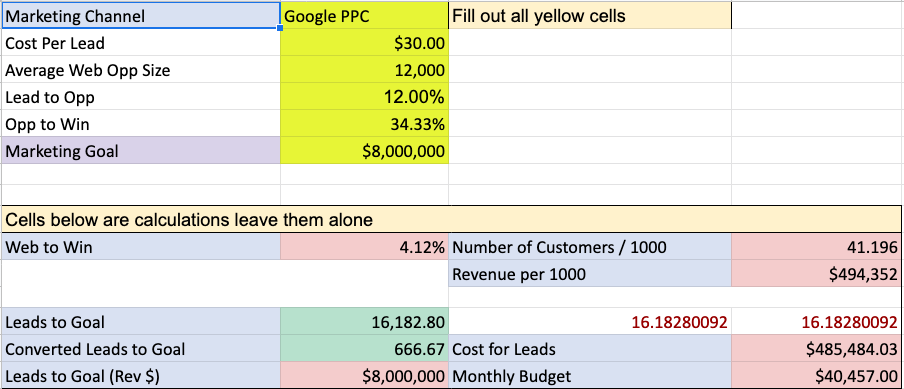Small and Medium Sized Business Marketing Quick-Hitters
I’ve lived most of my professional life in the startup, small, and medium-sized business worlds. In this SMB world, marketing departments usually consist of one or two people. In this type of employee mix, you often find the marketing department spending more time on internal marketing projects for various departments. I’m here to tell you that you can proactively move your marketing departments out of these ruts. You start this process by eliminating a bunch of low-hanging fruit, and you can do it without a lot of money.
Here are some common elements of marketing that I often find missing in smaller organizations with small marketing departments.
Number 1. Standardized Reporting
Standard reporting is a complicated topic, and depending on what type of data you collect, you may not get much value. With that being said, I believe there are two types of reports that apply across the board and create value for every stakeholder.
Marketing / Demand Gen Waterfall
First, you should start working on a marketing waterfall. This type of document will let you work backward into a budget. The attached Google Spreadsheet (Demand Gen Reverse Waterfall) can be copied and will make a lot of sense as you work through your own.

Buyer-Based Marketing marketing reverse waterfall / demand waterfall available on Google Spreadsheets
To get started here, you need to know a few things:
- The average cost of a lead
- How many web leads convert into an opportunity
- Your average web-generated lead revenue
The information above will then let you play around with the other non-formula based fields on the spreadsheet to arrive at a budget number. Say, if you need to generate $5M from your website, you can figure out how many leads you need to produce, and what that will cost you. The conversation around your web marketing budget gets much easier when you have this information available. You can also get granular and fill out one of these spreadsheets for every channel, but I don’t think that’s usually necessary.
Per-Channel Activity with ROI
The second type of report that I believe needs to be available for stakeholders is a per-channel breakdown of web activity. You should be able to show how your social media, organic search, and paid advertisements all work together to create a cohesive marketing story on the internet. A per-channel report can prove the effectiveness, ROI, and long-term intrinsic value of each channel and how your content types are being consumed. These can also show paid contributions to organic growth over time, one of the most important indicators of successful content marketing. In an excellent per-channel report, you can show trends among channels against the backdrop of organic visits. If you monitor channel, content type, and engagement metrics separately, you can overlay the data to complete the picture of success or failure.

Tools like SEMrush can help automate per-channel analytics. Moz, Raven, and other options exist as well.
Number 2. A Brand Guide and Associated Templates
A brand guide along with the templates it helps create rarely exist in this space for B2B companies, or at least none of the ones that I have experienced. In fortunate cases, a brand guide may exist, but no one uses it as the resource it is meant to be. A useful brand guide, when used correctly, is a tool that can make lives more comfortable, and establish a company in a market over time, organically.
If you have no idea where to start, you can see some pretty great templates over at graphicriver.net, or you can search for brand guide template on Google. Software solutions also exist that can help you create an interactive brand guide. Some of those digital tools can also make it easier to get your materials out to internal stakeholders. No matter how you get it done, the purpose of a brand guide is to set brand policy and give examples of what is OK and what is not acceptable. More important than the quality of the guide itself, is the enforcement of policy as outlined in the document.
I would argue that creating brand recognition and maintaining it throughout a customer’s lifecycle is one of the most critical factors in any business transaction. Your brand should represent everything about your company that is better and different from competitors – that’s how they come to recognize value without explanation.
Don’t release the guide without templates
A big mistake to avoid is the attempted enforcement of a brand standard is trying to tell people what’s coming without having it ready. If you serve a variety of sub-industries, make decks for each of them. Make extra slides. Ensure that you have what you need before you go to the field and tell people what they need to be doing. Be open to feedback from salespeople and be ready to change your standard based on the needs of the organization. Marketing people rarely have to give these presentations to customers, if you have, you’d realize how bad most of them are.
Standard templates to have ready when releasing your brand guide:
- Business cards
- Powerpoint/Keynote templates
- Sell sheets
- Brochures
- Quotes
- Proposals

Brand management software can help you create and control your brand
Become a tactical strategist
Marketing tactics are only as good as the strategy they support, and the opposite is true as well. You can have a great strategy, but without effective tactics, you’ll never get past ideation. The two quick-hitters I list here are great ways to get started walking the walk, and they are both essential aspects of the SMB marketing plan. Creating and sticking to a brand guide, providing support for stakeholders, and ensuring that your value to customers is synonymous with your name will help your business. Standardized reporting lets you show that your tactics are working (or failing), and will give those you report to a clear understanding of what it is that you’re doing.




